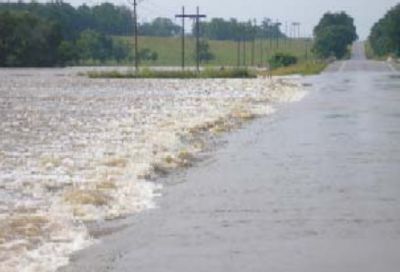748.2 Roadway Design Criteria: Difference between revisions
m Per Bridge, clarification of overtopping flood |
m Per TP, updated Major Highway System map |
||
| (8 intermediate revisions by 2 users not shown) | |||
| Line 1: | Line 1: | ||
[[Image:748.2 Photo Roadway Overtopping2.jpg|thumb|Flash Flooding on Rt. F Barton County | [[Image:748.2 Photo Roadway Overtopping2.jpg|thumb|Flash Flooding on Rt. F Barton County|400 px]] | ||
==748.2.1 | ==748.2.1 Roadside Ditch and Culvert Frequency Criteria== | ||
See [[:Category:749 Hydrologic Analysis#749.2.1.2 Roadside Ditches and Culverts|EPG 749.2.1.2 Roadside Ditches and Culverts]]. | |||
==748.2.2 Crossroad Structure Frequency Criteria (Roadway Design Frequency)== | |||
===748.2.2.1 [[media:144 Major Highway System 2022.pdf|Major Routes]]=== | |||
On Major Routes, for bridges and box culverts, the water level shall be no higher than 1 foot below the lowest shoulder point during a 50- to 100-year event. For bridges and box culverts on interstates use the 100-year event. For pipes, the water level shall be no higher than 1 foot below the lowest shoulder point during a 25- to 50-year event. For pipes on interstates use the 50-year event. | |||
==748.2.3 High Water Marks== | ===748.2.2.2 Minor Routes=== | ||
On Minor Routes, for bridges and box culverts, the water level shall be no higher than 1 ft. below the lowest shoulder point during a 25- to 50-year event. For pipes, the water level shall be no higher than 1 ft. below the lowest shoulder point during a 10- to 25-year event. | |||
===748.2.2.3 New Locations=== | |||
For new locations, consider the expected traffic volumes and length of roadway to be constructed in selecting the roadway design frequency. | |||
===748.2.2.4 Replacement Structures=== | |||
For structure replacements, the lower end (i.e., 100-year) of the hydraulic frequency ranges is used for high volume routes and sites requiring only minimal roadway work. The upper end (i.e., 25-year) of the hydraulic frequency ranges is used for low volume routes and sites requiring extensive roadway work. The replacement structure should be designed so that it does not increase the roadway design frequency. | |||
===748.2.2.5 Rehabilitated Structures=== | |||
When rehabilitating an existing structure it is not required that the adjacent roadway be raised to meet the roadway design criteria for new roads. | |||
===748.2.2.6 Project Scope=== | |||
When applicable, the project file shall include a note indicating that improving the roadway design frequency is outside the scope of the project. | |||
==748.2.3 Overtopping Flood== | |||
The [[:Category:749 Hydrologic Analysis#749.2.3 Overtopping Flood|overtopping flood]] is the actual flood at which flow occurs over the roadway. It is used as a design scour event and is the overtopping event reported on the plans. | |||
==748.2.4 High Water Marks== | |||
The districts shall keep a record of the elevation of high water marks during floods for future design purposes. High water marks should be indicated on roadway structures if possible and labeled with the year of the occurrence. | The districts shall keep a record of the elevation of high water marks during floods for future design purposes. High water marks should be indicated on roadway structures if possible and labeled with the year of the occurrence. | ||
[[Category:748 Hydraulics and Drainage|748.02]] | [[Category:748 Hydraulics and Drainage|748.02]] | ||
Latest revision as of 08:17, 3 June 2022

748.2.1 Roadside Ditch and Culvert Frequency Criteria
See EPG 749.2.1.2 Roadside Ditches and Culverts.
748.2.2 Crossroad Structure Frequency Criteria (Roadway Design Frequency)
748.2.2.1 Major Routes
On Major Routes, for bridges and box culverts, the water level shall be no higher than 1 foot below the lowest shoulder point during a 50- to 100-year event. For bridges and box culverts on interstates use the 100-year event. For pipes, the water level shall be no higher than 1 foot below the lowest shoulder point during a 25- to 50-year event. For pipes on interstates use the 50-year event.
748.2.2.2 Minor Routes
On Minor Routes, for bridges and box culverts, the water level shall be no higher than 1 ft. below the lowest shoulder point during a 25- to 50-year event. For pipes, the water level shall be no higher than 1 ft. below the lowest shoulder point during a 10- to 25-year event.
748.2.2.3 New Locations
For new locations, consider the expected traffic volumes and length of roadway to be constructed in selecting the roadway design frequency.
748.2.2.4 Replacement Structures
For structure replacements, the lower end (i.e., 100-year) of the hydraulic frequency ranges is used for high volume routes and sites requiring only minimal roadway work. The upper end (i.e., 25-year) of the hydraulic frequency ranges is used for low volume routes and sites requiring extensive roadway work. The replacement structure should be designed so that it does not increase the roadway design frequency.
748.2.2.5 Rehabilitated Structures
When rehabilitating an existing structure it is not required that the adjacent roadway be raised to meet the roadway design criteria for new roads.
748.2.2.6 Project Scope
When applicable, the project file shall include a note indicating that improving the roadway design frequency is outside the scope of the project.
748.2.3 Overtopping Flood
The overtopping flood is the actual flood at which flow occurs over the roadway. It is used as a design scour event and is the overtopping event reported on the plans.
748.2.4 High Water Marks
The districts shall keep a record of the elevation of high water marks during floods for future design purposes. High water marks should be indicated on roadway structures if possible and labeled with the year of the occurrence.